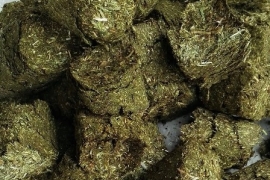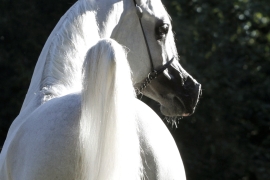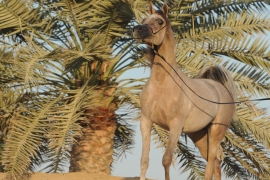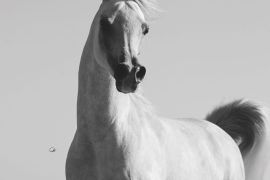A sketch study of the Arabian Face: the magic is in the eyes
There are many reasons why I focus my art career around the Arabian horse, but none make my fingers long to paint more than the desire to capture the beauty of the face.
I think we would all agree that one of the most captivating things about the Arabian horse is their dished head. The lovely contours of the forehead, tear bone and jawline reaching down to delicately flared nostrils and small muzzle, truly sets them apart from other breeds.
In art, my Arabian’s face may have exaggerated features but I believe it is important to understand the anatomy first, in order to properly communicate the essence of those features. A quote attributed to the great artist Picasso says, “Know the rules like a pro, so you can break them like an artist” and I think this is something that every artist ought to subscribe to. Even though I may not necessarily need to paint every last detail of the face or may not want to paint with absolute realism, to capture and express the breed fully I have to understand its anatomical structure.
In this post I’d like to break down what comprises a beautiful Arabian face by studying my favorite feature: the eyes.

The breed standard according to the USEF states that the Arabian horse should have: “large, round, expressive, dark eyes set well apart ...at a comparatively short distance between eye and muzzle”.
It’s easy to get lost in the refinement and dished shape of the face but I would argue that the key to a truly exquisite Arabian horse head is massively dependent on the eyes. So much beauty and expression is held there that it is enough to make or break the entire look of the face. No matter how extreme the face shape, small or badly set eyes can nearly destroy the appearance.

The anatomy of a horse’s eye.
THE EYE SOCKET or BROW BONE

Much of the expression in a horse’s face comes from the socket. Also called the orbit, this is the part of the skull that contains and protects the eyeball and consists of several bones and muscles. You could think of the socket as the horse’s eyebrows...and a well shaped eyebrow is a key feature of the face, in both horses and humans! The ideal socket is large and pronounced with musculature that curves in an upward triangular arch over the eye. This muscle with its fine brow creases gives the Arabian horse an intelligent, kind expression. 
The hair surrounding the socket is often clipped for shows in order to accentuate it. The lashes must not be cut, and depending on the rules of the show, the whiskers must be left too. A proper clip can even create the effect of a good eye socket on a horse that might otherwise be lacking. But there is no mistaking the difference between a true socket shape and one that is skillfully manufactured. I find the look of a good show clip on an Arabian face beautiful but I believe that same Arabian should be just as lovely in its natural state and this can only be accomplished when the bone structure is correct.

THE EYE SIZE
Horses have some of the largest eyes of any land mammal and the Arabian in particular has especially large eyes in relation to the rest of the face. For example, eye proportions that would look perfectly nice on a warmblood would appear much too small on an Arabian. This is mostly due to the fact that Arabians have smaller heads compared to other breeds, with eyes prominent in the face. 
Notice the difference in distance between the eye and the nostril on this Arabian vs. the warmblood and the relation between eye size and the face structure. The warmblood is perfectly nice as he is but such proportions on an Arabian would be undesirable.
EYE PLACEMENT
Socket and eye size are important, but the most essential thing I watch for when sketching is the placement of the eye. No matter what face shape any particular horse has, the position of the eyes has the strongest impact on the overall look of the face.
The eye should be placed relatively low and when sketching, the best way I’ve found to measure this is to place the upper eyelid roughly one ‘ear length’ down. Imagine duplicating the length of the ear and placing it end to end. The lash line of the upper eyelid should sit at least one ear length from the base of the ear. This method isn’t foolproof but as long as the horse has correctly proportioned ears, it’s a good way to check to be sure the eyes are placed low enough on the face. Naturally, if the horse has oversized or very large ears, the measurements will be a bit off but as a basic guide, it is helpful.

Setting the eye ‘one ear length’ from the ear is measurement tactic I use to make sure my eye placement is correct.

The eye placement on a horse with a pronounced forehead or jibbah is perhaps the most difficult to draw correctly. Eyes set too high creates a strange appearance often called a ‘dolphin head’, with the majority of the jibbah appearing in front of or below the eye line, similar to the face shape of a dolphin.

Eye placement on a head with a pronounced jibbah.
Alternately, if the eyes are too low it can give the horse an immature, foal-like appearance. Commonly this is the way a foal’s head is shaped: a bulging, high-set jibbah that typically flattens as the bone structure matures and the foal ages. Since we want low set eyes in an Arabian this isn’t as much of a problem as high set eyes. It does create a more extreme look but when drawing a face that is more realistic, it’s better to avoid placing the eyes too low (unless drawing a foal), because it can give the horse a cartoon or caricature appearance.
If I’m drawing a pronounced jibbah, I prefer to keep the eye placement neither too high, nor too low. I do this by aligning the top eyelid with the apex (uppermost point) of the jibbah’s curve.

Foals naturally have low set eyes compared to the jibbah.
FAULTS and DEFECTS
The eyes on an Arabian horse must always be dark in color, nearly so dark that the pupil is not easily distinguishable and the iris (the pigmented portion of the eye surrounding the pupil) should extend beyond the outer rim of the lid on all sides of the eyeball. Ideally, we should see very little to no white even when the eye is opened at its widest. A correctly conformed horse may expose the whites of its eyes when they are rolled back in fear or extreme aggression, but any white in the eye that’s visible when the horse is at rest would be considered a fault.
When excessive white in the eye shows all the way around the rim of the eyelid it creates a highly undesirable ‘human’ eye. Although this can occur on its own, most commonly this fault appears when the horse has a large face marking like a blaze that is too close to the eye. The skin beneath any white marking is always light in pigment and if that light pigment reaches the eye area, it can cause the occurrence of excess of white in the eye or even a blue eye (also called a glass or wall eye). All of these are unacceptable traits in the breed. The eyes should always be dark, clear and liquid. Additionally any opaque cloudiness to the eye, especially in the pupil area will indicate a defect such as blindness or injury.
When drawing or painting, I try to keep the eye as dark as possible, and the only white areas should be the ‘catch lights’ where the light source strikes the surface of the lense, reflecting off of it.

Notice how the horse in the lower left corner of this sketch has a blaze that overlaps part of the eye socket, likely causing that blue eye. And the horse in the upper right hand corner is not necessarily showing a fault because the white is visible only because the eyes are rolled back in surprise.
I love so many things about the Arabian horse; their upright finely arched neck, delicate face, proud, high-set tail and athletic, spirited nature... but there is something in the eyes that is enchanting to me. Who can forget the the intense expression of fire and charm in the eyes of a stallion or the look in a mare’s eyes when she reaches back to greet her foal for the first time?
Kindness, fear, playfulness, ...the Arabian horse doesn’t just have expression, they are expression. And though many factors determine the quality of the Arabian head, the eye in its composition and its expression is the thing that ties all the other aspects of the face together, creating a beauty that is treasured around the world.








